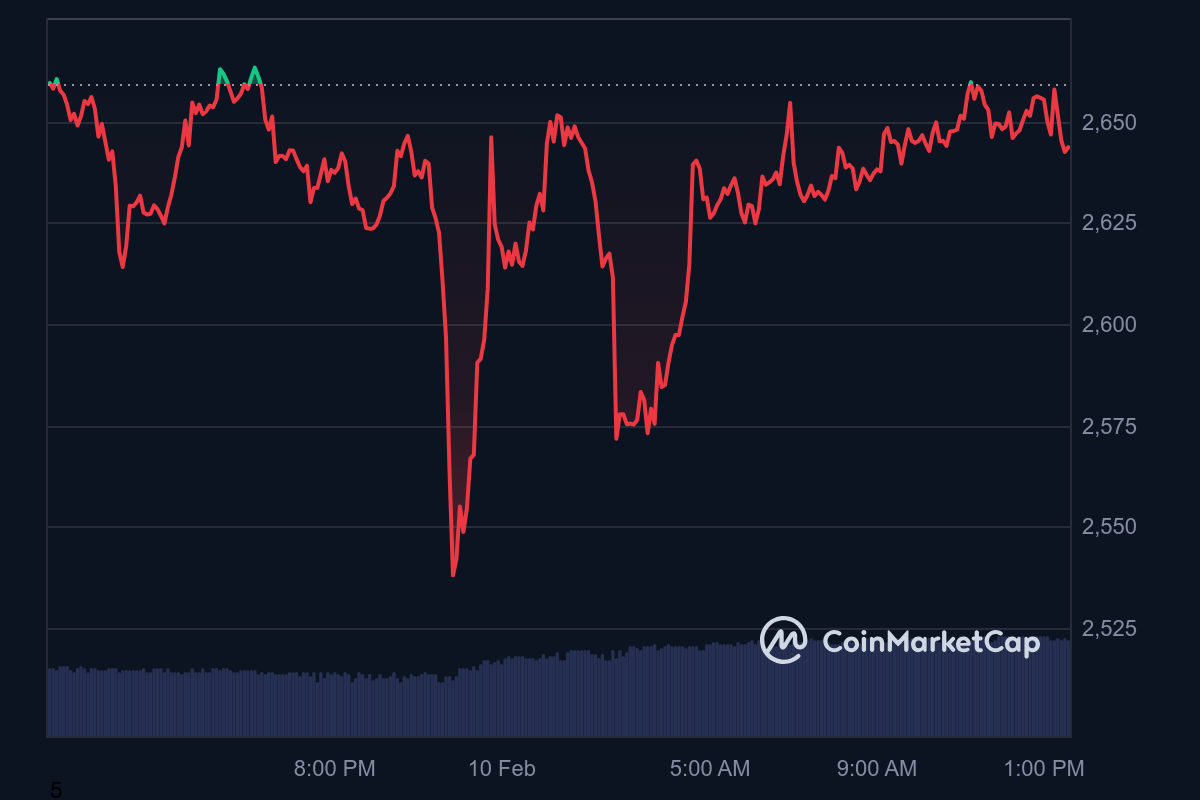Last updated:
 Why Trust Cryptonews
Why Trust Cryptonews

On February 8, data from Token Terminal revealed that Ethereum’s daily transaction fees dropped by $731,472, marking the first time in five months that revenue fell below $1 million. The asset also faces pressure from a record level of short selling through futures contracts.
While some see this decline in Ethereum fees as a sign of weakening demand, others believe it could be a temporary dip before a potential market rebound.
Ethereum Fees and Price Drop, Raising Concerns
The last time Ethereum experienced such a prolonged fee slump was between August 17 and September 8, 2024. Before that, a similar drop did not occur since November 2020.
While broader market trends and regulatory uncertainties have contributed to Ethereum’s struggles, its rising supply is a key factor behind this downturn. Since April 2024, Ethereum’s total supply has been steadily increasing, reversing the deflationary effects introduced by the Merge in September 2022.
The Merge shifted Ethereum from a mining-based proof-of-work system to a proof-of-stake model, substantially reducing new ETH issuance. However, the supply has surpassed pre-Merge levels, contributing to Ethereum fees and price decline.
Ethereum’s struggles may stem from rising competition with emerging rivals like Solana (SOL) and Ethereum layer-2 networks. Persistent concerns over scalability, high Ethereum fees, and costly transactions have only added to the pressure, with the Ethereum Foundation making slow and frustrating progress in addressing these issues.
Adding to Ethereum’s woes, short selling has reached unprecedented levels.
Data from ZeroHedge indicates that futures contracts on the Chicago Mercantile Exchange (CME) have surged to a record high of 11,341 contracts. This sharp rise, reflecting a 40% increase in just a week and a dramatic 500% jump since last November, signals deepening bearish sentiment.
The Kobeissi Letter, a leading market analysis platform, noted that such spikes in short positions have historically preceded steep ETH price declines.
A recent market event further highlighted Ethereum’s vulnerability. On February 2, Ethereum suffered a 37% drop within 60 hours following former U.S. President Donald Trump’s trade tariff announcement.
Ether has also underperformed relative to Bitcoin. While Bitcoin has surged close to its all-time highs, ETH has remained stagnant. Ethereum trades around $2,649 at press time, largely flat over the past 24 hours and still 45% below its November 2021 peak.
In contrast, Bitcoin is only 10% below its record high of $109,000, reached in mid-January 2025.
For now, all eyes remain on whether Ethereum fees and network activity can recover to restore confidence in the asset.
Ethereum ETFs Have Failed to Fuel ETH Price to Higher Levels
ETH has fallen short of investor expectations over the past year, failing to reach new highs despite the approval of spot exchange-traded funds (ETFs) in major markets such as the United States and Hong Kong.
Many had anticipated that the launch of ETH ETFs would provide a strong catalyst for a price surge, mirroring Bitcoin’s meteoric rise following the approval of its ETFs. However, the price of ETH has remained largely stagnant, raising concerns about Ethereum’s market positioning and future growth.
Institutional investors continue accumulating ETH through spot ETFs, with BlackRock’s Ethereum ETF alone recently seeing over $500 million in inflows. Trump’s son, Eric, has also advised investors to add more ETH to their portfolios, further fueling optimism.
Despite these positive signals, the impact on ETH price has been underwhelming.
The latest setback came from the U.S. Securities and Exchange Commission (SEC), which once again delayed its decision on approving options trading for ETH ETFs. The delay affects key asset managers, including Bitwise, Grayscale, Ethereum Mini Trust, and BlackRock.
The SEC justified its postponement by stating that more time was needed to evaluate the proposed rule change and consider public feedback.
With Ethereum fees still an issue and ETH ETFs failing to deliver the bullish breakout investors had hoped for, the path forward for ETH price remains uncertain.
If the SEC continues to delay ETF-related decisions, this could signal broader regulatory challenges for Ethereum and dampen investor sentiment.
Market participants will be watching on-chain data and regulatory developments closely to see if Ethereum can overcome these hurdles and regain momentum.



